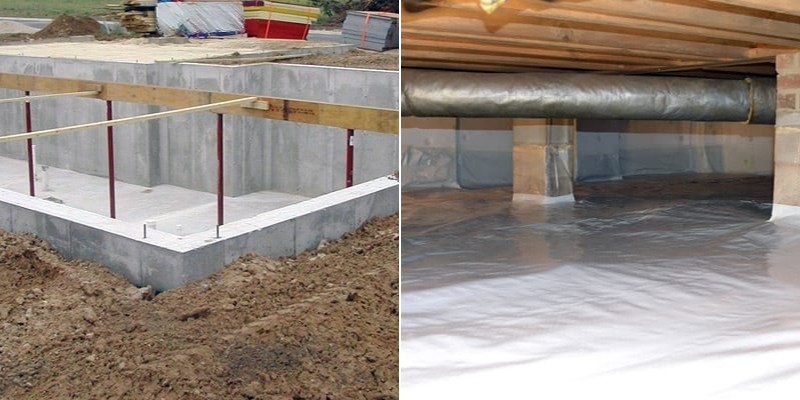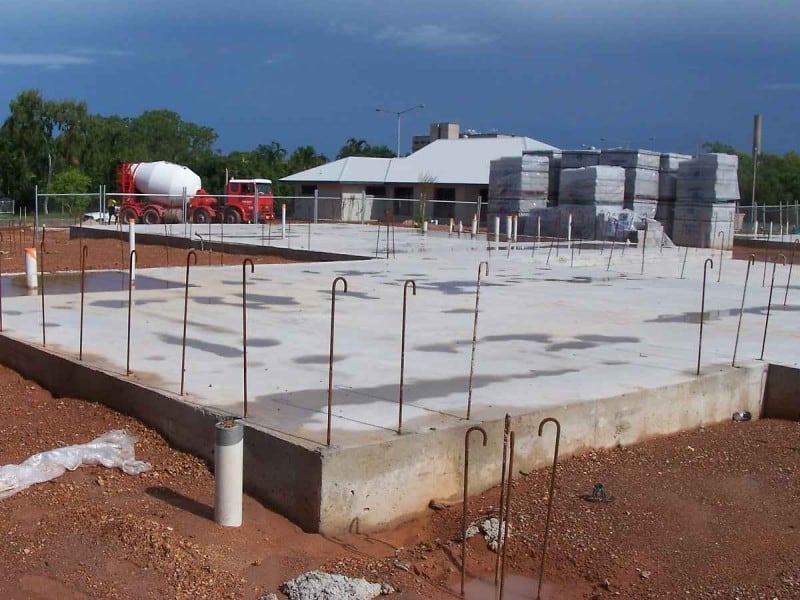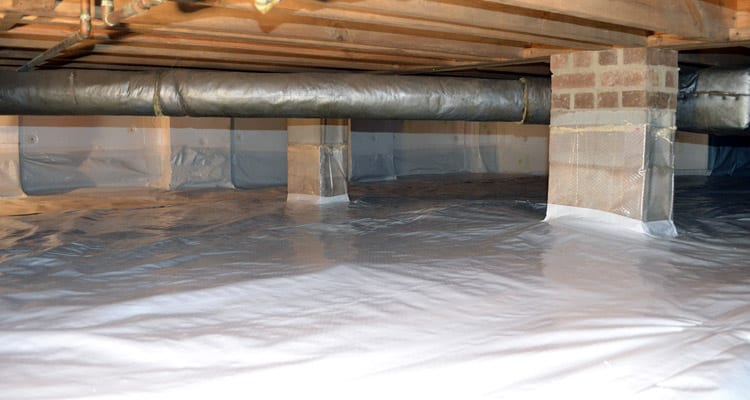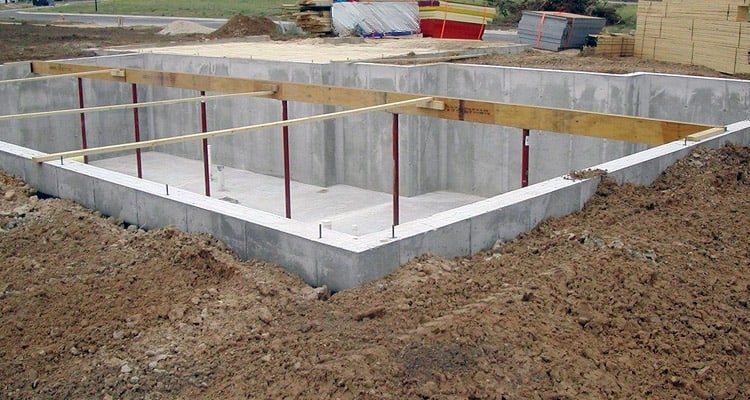Your home’s foundation is one of the most important aspects to consider when purchasing a home or building your dream home. It is the key to retaining structural integrity throughout the house, keeping Mother Nature’s rains and storms at bay, and supporting your home for years of trouble-free, comfortable living.

The foundation also impacts the aesthetics of your home.
Because beauty is “in the eye of the beholder,” some homeowners may prefer the ground-level perspective a slab offers. In contrast, others will like the elevated look of a crawl space or basement foundation.
In this post, we will examine the three most popular foundations used in home construction (although there are some others as well):
- Slab
- Crawl space
- Basement
Concrete Slab Foundation
This foundation is the cheapest to construct. It consists of a concrete floor, or slab, about 4-6” thick and is poured on a bed of sand and rock for drainage purposes.

Since these are at ground level, there is no crawl space or basement. Slab foundations are popular in warm climates where the ground doesn’t freeze, leading to foundation cracks.
Crawl Space
A crawl space foundation is popular where the land slopes, the area is prone to earthquakes, or is in a flood zone.

Footings are poured, and blocks are set atop these to create the foundation. The home is above ground level, so there is a “crawl space” under the house, which can vary in size, depending on your site’s geography.
Plumbing, HVAC, and electrical conduits are run throughout the crawl space, making them easier to access for repairs.
Encapsulating the crawl space might be needed in some cases when there are humidity problems coming from the foundation.
Basement
A basement foundation takes the best of what a slab and crawl space offer. You get the perks of a slab floor with concrete or cinder block walls that provide another living area.

In older basement foundations, cinder block was used, but it is prone to crack and having water issues. Nowadays, contractors opt for poured concrete walls that eliminate many of these issues.
Basement foundations are the most expensive of the three to construct, and because the footings need to be below the frost line, these are popular in colder climates.
Advantages of a basement foundation are an additional living area, a storm shelter, and easier access to HVAC, plumbing, and electrical conduit for repairs.
All three foundations have their advantages and disadvantages, so there isn’t one that stands out as the clear winner. In our next section, we will make a side-by-side comparison, so you may decide for yourself which suits your needs.
Slab vs Crawl Space Comparison
Cost:
If price alone were the objective, then the slab foundation would win hands down. They can be half as expensive to construct as crawl space foundations, but there are other factors to consider, as we’ve alluded too already.
Geography:
Where you live may be the deciding point for which foundation is best for you. If you live where there are earthquakes, or the land is hilly, or the soil isn’t stable, or flooding is a possibility, then a crawl space foundation is your best option.
On the flip side, if you’re in a wet region that is relatively flat with stable soil, a slab foundation would work.
Construction:
All the foundations mentioned above require proper grading and preparation, so be sure you’re selecting a contractor who understands this importance.
Slab foundation sites need to be level to provide proper drainage away from the home. A mixture of gravel and soil is spread over the lot to give the slab a firm base and protect it from shifting ground.
This underlayer protects concrete from potential cracks, fissures, and high and low spots. Next, plastic or other insulation is rolled out over the entire area to act as a vapor barrier. The vapor barrier prevents moisture from affecting the concrete and mold, insects, and radon from entering the home through the floor.
Before pouring the concrete, rebar is used to strengthen the concrete to prevent shifting, cracking, or shrinking. The plumbing and electrical conduits are also installed in this phase inside the concrete slab. The home’s HVAC ductwork and plumbing are run through the attic. Even with all of this work, a slab foundation is the fastest of the three to complete.
Crawl space foundations also require a level lot and proper grading to ensure that rainwater flows away from the home. If the house sits on bedrock, added costs may occur when the contractor has to dig through bedrock.
Like a slab foundation, plastic is laid on the ground to act as a vapor barrier. However, instead of burying the HVAC, plumbing, and electrical conduits, these are secured in the crawl space, making them easy to access for repairs.
Even with proper grading and functioning gutter systems, heavy rains could seep into the best-constructed crawl space, leading to mold growth.
The height of the crawl space is contingent upon the lot’s geography. If built on a slope, a crawl space could be high enough to walk into, giving you additional storage space.
Durability:
Both a slab and crawl space foundation are equally durable if appropriately constructed. Properly maintained foundations can last up to 50-years. With that all said, here are some things to consider.
- Leaky pipe. In a crawl space, a leaking water line can lead to rot, mold but because the conduits are accessible, repair costs can be lowered. If a pipe leaks or breaks in a slab foundation, repair costs rise since the concrete needs to be cut out and removed to reach the pipe. Pex plumbing systems, which are becoming more popular with builders, help negate this need to crack open the concrete.
- Tree roots. If your home has trees near the foundation, the roots could become an issue. In a crawl space, the damage is limited and may only affect the vapor barrier or a foundation wall. Conversely, roots beneath a slab could potentially break and crack the slab, leading to costly repairs.
Comfort-Savings:
If you are elderly or have mobility issues, a slab foundation is ideal since steps aren’t needed to enter the home.
Slab foundations offer the best support if you have heavy furniture, but the payoff is that they are not comfortable to stand on for long periods. A crawl space with a wood subfloor is more comfortable and easy on one’s joints.
A slab foundation is more energy efficient because there is no airflow beneath the home like there is in a crawl space. This saves money when heating and cooling the home. However, other homeowners comment that crawl space floors are warmer because air under the house acts as a thermal buffer.
Regarding resale value, both are equal if they have been adequately maintained and are in good condition. However, there is aesthetics to consider.
If your neighborhood consists of primarily slab foundations, but yours is a crawl space, being the “odd duck” may detract from the look as well as resale value the market offers. The reverse scenario is true as well.
Slab Vs Basement Comparison
Without being redundant, we’ll assume that you live in a region where both of these foundations are options.
Cost:
The basement foundation is by far the most expensive and time-consuming option. If your budget is tight, then your best option may be a slab foundation. However, in the long run, it may be more expensive. Here’s why:
- If the other homes in your neighborhood have a basement or crawl space foundations, a slab foundation may be viewed as “cheap” and will affect your resale price.
- Adding an addition to your home will be more expensive than with either of the other foundations.
- Tree root damage, cracks, or other repairs that require digging up portions of the slab are costly.
Durability:
If constructed properly, especially with attention to water drainage, both foundations will last for years.
Comfort-Savings:
As mentioned earlier, a slab foundation can be uncomfortable to stand on since it is solid concrete. Like a crawl space foundation, basement floors offer the same comfort.
Although basement foundations are more expensive to construct, they do offer some financial benefits:
- Additional living space and square footage.
- Easier repair access.
- Year-round comfort.
- Storm protection.
If your lot is on a slope, a basement foundation will give you walk-out accessibility to ground level. This opens the door to various decorating and landscaping options that will give your home a uniqueness all its own.
A significant drawback to basements is the potential for flooding. Your contractor can minimize this threat by taking extra measures to ensure rainwater flows far from the foundation.
Even with the best foundation construction, flooding can occur. For such emergencies, install a sump pump that has a backup battery or generator.
Crawl Space Vs Basement Comparison
Cost:
As previously stated, the crawl space will be significantly cheaper to build than a basement foundation. However, both require about the same amount of time to construct.
Durability:
When constructed properly and following grading and water flow guidelines, both foundations are equally durable and can last for many years.
Comfort-Savings:
Since the home’s main floors are not a slab of concrete, they are more comfortable on one’s feet and joints.
Of course, the basement floor will not be the case as it is solid concrete. Both foundations’ primary floors are warmer than slab foundations since there is conditioned air beneath the flooring.
Accessing HVAC, plumbing, and electrical conduits for repairs is more accessible in a basement foundation than in a crawl space.
Such access could save money down the road since workers can stand to work instead of crawling on their hands and knees, which is more time-consuming.
Because a basement has a concrete slab for flooring, it reduces the risk of radon, moisture, and insects from entering the home.
As previously mentioned, the biggest downfall of a basement foundation is that they are susceptible to flooding. Be sure you have a sump pump for such an emergency.
Even with proper grading, gutters, and water vapor, crawl spaces are susceptible to moisture, leading to mold, rot, and insects.
Radon gas can also enter the home because there isn’t concrete flooring. Although crawl spaces can’t compete with basements in the additional storage space offered, there is some space available, especially those with a sloping lot.
When it comes to resale value, a home with a basement is usually more appealing to home buyers than those with a crawl space. Although it will cost more initially, a basement may be worth the investment when it’s time to sell, especially if remodeled into a living area.
The Bottom Line
We hope this has helped you understand the differences between these three popular foundations and the advantages each offer.
As we’ve mentioned repeatedly, the key to building a trouble-free foundation is to find a contractor who understands the importance of grading and water drainage.
These all-important criteria spell the difference between a foundation that will be prone to repairs and one that will last for years.
Sources
https://www.fixr.com/comparisons/slab-vs-crawl-space#cQ
https://www.reinbrechthomes.com/blog/3-most-common-house-foundations-the-pros-cons/
Related Posts
- Comparison of Shiplap vs “Tongue and Groove” vs Beadboard Wall Paneling
- Comparison of Manufactured vs Modular Homes with Pros/Cons
- 10 Different Types of Glass for Home Windows (With Pros and Cons)
- Here Are The Main Pros and Cons of a Barndominium House
- Main Advantages and Disadvantages of Vaulted Ceilings for Homes
- Top 9 Drywall Alternatives for Your Home Ceiling (With Photos)
Leave a Reply